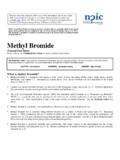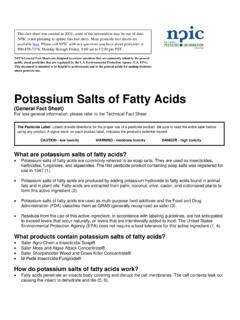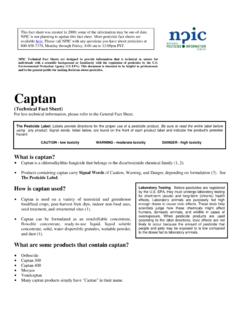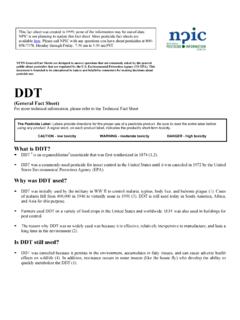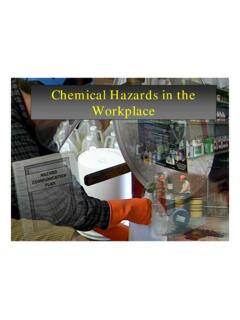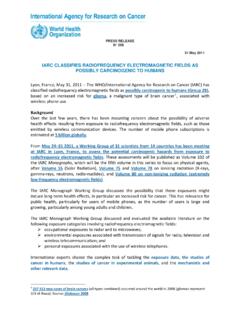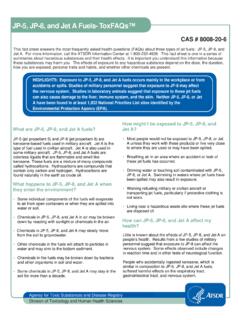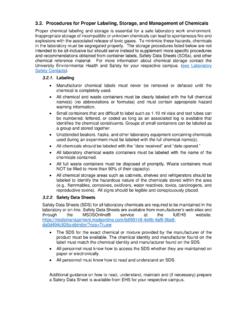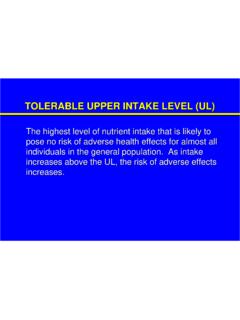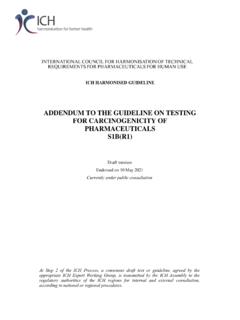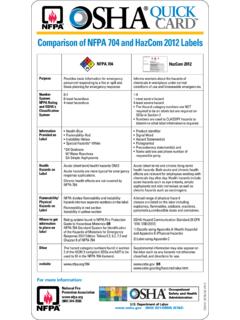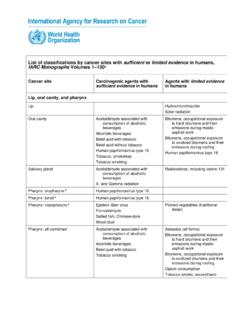Transcription of US EPA - Chemicals Evaluated for Carcinogenic Potential ...
1 1 UNITED STATES ENVIRONMENTAL PROTECTION AGENCY WASHINGTON, 20460 OFFICE OF CHEMICAL SAFETY AND POLLUTION PREVENTION MEMORANDUM DATE: October 27, 2021 SUBJECT: Chemicals Evaluated for Carcinogenic Potential by the Office of Pesticide Programs FROM: Rick Fehir, , Chief Science Information Management Branch Health Effect Division (7509P) Office of Pesticide Programs TO: Division Directors AD, BPPD, EFED, HED, PRD and RD The attached list provides an overview of Chemicals Evaluated for Carcinogenic Potential by the Health Effects Division (HED) of the Office of Pesticide Programs (OPP) available through July 2021.
2 Applying the Agency s Guidelines for carcinogen Risk Assessment, the classification of the chemical is made by HED s Cancer Assessment Review Committee (CARC) or, in the case of where there is no evidence of carcinogenicity, by the HED Risk Assessment Team. This list includes the chemical name, CAS Number, PC code, the cancer classification, report date, test species and tumor type(s) as well as method of quantification of cancer risk and established mode of action, as applicable. It should be noted that the evaluation of many of these Chemicals is an ongoing process, therefore, the information in this list ( , classification and/or the quantification) may be subject to change as new and/or additional data are submitted to OPP.
3 This list should not be used as the single source for either the classification or quantification of the Carcinogenic Potential . This list will be updated annually. If further information is required, please contact Rick Fehir, Phone: 202-566-2193; E -mail: 2 Chemicals Evaluated for Carcinogenic Potential Science Information Management Branch Health Effects Division Office of Pesticide Programs Environmental Protection Agency BACKGROUND What is this list? The Chemicals Evaluated for Carcinogenic Potential provides an overview of the compounds Evaluated for carcinogenicity by the Health Effects Division of the Office of Pesticide Programs.
4 NOTE: As new information becomes available, the list may become out-of-date. Therefore, it should not be used as the sole reference regarding the Carcinogenic Potential for a pesticide. EPA intends to update the list each year to include new evaluations or re-evaluations. How does EPA review pesticides for Potential carcinogenicity? The Health Effects Division of the Office of Pesticide Programs performs an independent review of studies conducted in mice and rats to evaluate the Carcinogenic Potential of pesticides. The results of the independent review are peer-reviewed by the Cancer Assessment Review Committee.
5 This committee recommends a cancer classification. The classification will determine how the Agency regulates the pesticide and will include methods for quantification of human risk. In some cases, EPA also requests review by the FIFRA Scientific Advisory Panel. What factors does EPA consider in its review of cancer risk? When assessing possible cancer risk posed by a pesticide, EPA considers how strongly Carcinogenic the chemical is (its potency) and the Potential for human exposure. The pesticides are Evaluated not only to determine if they cause cancer in laboratory animals, but also as to their Potential to cause human cancer.
6 For any pesticide classified as a Potential carcinogen , the risk would depend on the extent to which a person might be exposed (how much time and to what quantity of the pesticide). The factors considered include short-term studies, long-term cancer studies, mutagenicity studies, and structure activity concerns. (The term weight-of-the-evidence is used in referring to such a review. This means that the recommendation is not based on the results of one study, but on the results of all studies that are available.) 3 When does EPA review pesticides for Potential carcinogenicity? EPA reviews studies submitted when a pesticide is proposed for registration.
7 Studies are required in two species (mice and rats) and two sexes (males and females). These studies are required for all pesticides used on food and some non-food pesticides that could lead to long-term exposures in humans. These studies may be reviewed again when a pesticide undergoes reregistration and the cancer classification may be reevaluated, particularly if new studies have been submitted. Why are there several different cancer classifications in the list? EPA s guidelines for evaluating the Potential carcinogenicity of Chemicals have been updated over the years to reflect increased understanding of ways Chemicals may cause cancer.
8 The current guidelines call for greater emphasis on characterization discussions for hazard, dose-response assessment, exposure assessment, and risk characterization, as well as the use of mode of action in the assessment of Potential carcinogenesis. EPA does not have the resources to re-evaluate every chemical to determine how it would be described under new guidelines, and there is no reason to re-evaluate Chemicals unless there is some new information that could change the basic understanding of that chemical. How have the guidelines changed? EPA issued its first set of principles to guide evaluation of human cancer Potential in1976.
9 In 1986, EPA issued updated guidance, which included a letter system (A-E) for designating degree of Carcinogenic Potential . In the 1986 guidelines, hazard identification and the weight-of evidence process focused on tumor findings. The human Carcinogenic Potential of agents was characterized by a six-category alphanumeric classification system (A, B1, B2, C, and D). In 1996, EPA released Proposed Guidelines for carcinogen Risk Assessment, which used descriptive phrases rather than the alphanumeric classification to classify Carcinogenic Potential . In the 1996 classification structure, increased emphasis was placed on discussing characterization of hazard, dose-response, and exposure assessments.
10 The hazard and weight of evidence process embraced an analysis of all relevant biological information and emphasized understanding the agent's mode of action in producing tumors to reduce the uncertainty in describing the likelihood of harm. By 1999, the science related to carcinogens had advanced significantly. EPA issued draft guidelines that continued the greater emphasis on characterization discussions for hazard, dose-response assessment, exposure assessment, risk characterization and the use of mode of action in the assessment of Potential carcinogenesis. In addition, the guidelines included consideration of risk to children, as well as addressing other issues such as nuances related to the amount and adequacy of data on a chemical.
